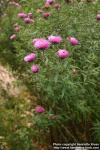The root of the Aster puniceus, Linné.
Nat. Ord.—Compositae.
COMMON NAMES: Red-stalked aster, Cocash, Meadow scabish, Squaw-weed.
Botanical Source.—The root of this plant is perennial and fibrous. It has a hispid stem, paniculate above, furrowed, generally red, or at least on the south side, stout and tall, growing from 3 to 6 feet in height. The leaves are oblong-lanceolate, amplexicaul, more or less auriculate at the base, sparingly serrate in the middle with appressed teeth, rough above, nearly smooth underneath and pointed; the lower leaves have remote serratures, are rough-edged, rough on the upper surface, and all acuminate and narrowed at the base. The involucre is loose and longer than the disk; the scales linear-lanceolate, long, revolute, nearly equal, in two rows. The flowers are large, showy, of a pale-purple or lilac-blue color, having from 30 to 60 long, narrow rays.
History and Description.—This plant is found growing in various parts of the United States, in swamps, ditches, along the borders of small streams, and sometimes in dry soils. It flowers from July to October. The radicles or fibers of the root are the parts used; they are about the size of a pipe-stem, having a pungent, aromatic odor and taste, with some bitterness and astringency. Water or alcohol extracts their active properties. This species has several varieties—vimineus,glaber, firmus, and candidus. The second variety and the candidus have white flowers.
Action, Medical Uses, and Dosage.—Stimulant and diaphoretic. The warm infusion may be used freely in colds, rheumatism, nervous debility, headache, pains in the stomach, dizziness, and menstrual irregularities. This, together with A. cordifolius, has been compared in value with valerian. Infusion (℥ss to aqua Oj) freely.
Related Species.—Aster aestivus, Aiton; Rheumatic-weed, Sampson snake-root, Star flower, etc., resembles the above plant, having lanceolate, subclasping leaves, tapering to the apex; margin rough; stem branching from its base, erect, hispid; branchlets pilose; involucre scaly; scales lax, linear, acute, equal. Flowers middle-size, blue. It is found more abundantly west of the Alleghany Mountains, and is recommended as an antispasmodic and alterative. Principally used in the cure of rheumatism in the form of infusion or tincture; recommended, however, in hysteria, chorea, epilepsy, spasms, irregular menstruation, etc., internally; and used both externally and internally in many cutaneous diseases, the eruption occasioned by the poison rhus, and in the bites of venomous snakes. Dose of the infusion, 1 to 4 fluid ounces; of a saturated tincture, ½ drachm to 2 drachms. This plant deserves further investigation.
Aster cordifolius, Linné. Heart-leaved aster. United States. According to Rafinesque (Med. Flora, II, 198), "an excellent aromatic nervine, in many cases preferable to valerian." It is also reputed antispasmodic. The root is the part used. A decoction has been used in rheumatism.
 Aster Novae-Angliae, Linné. New England aster. United States. A beautiful plant, especially when cultivated. It has rose-purple, occasionally white flowers. Used in skin eruptions and valuable for poisoning by poison sumach (Rafinesque, on authority of Dr. Lawrence).
Aster Novae-Angliae, Linné. New England aster. United States. A beautiful plant, especially when cultivated. It has rose-purple, occasionally white flowers. Used in skin eruptions and valuable for poisoning by poison sumach (Rafinesque, on authority of Dr. Lawrence).
Seriocarpus tortifolius, Nees (Aster tortifolius, Michaux). White-tipped aster, Mouse ear. Pine barrens of the United States. Summit usually covered with insects (Porcher). Diuretic.

